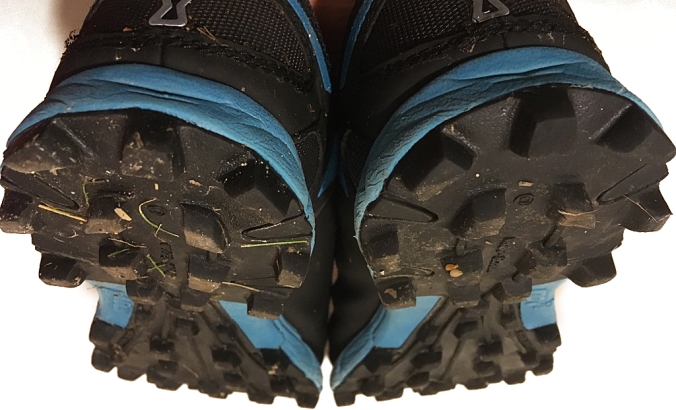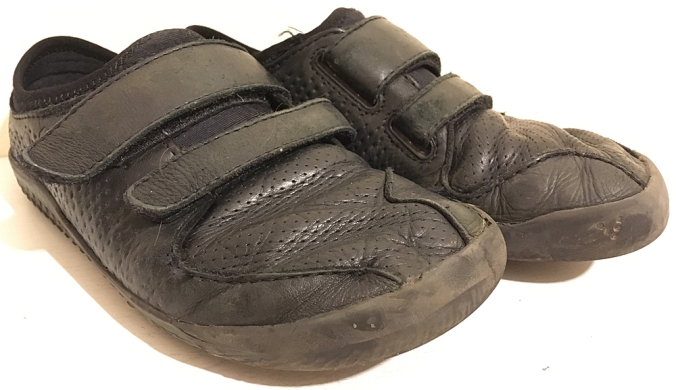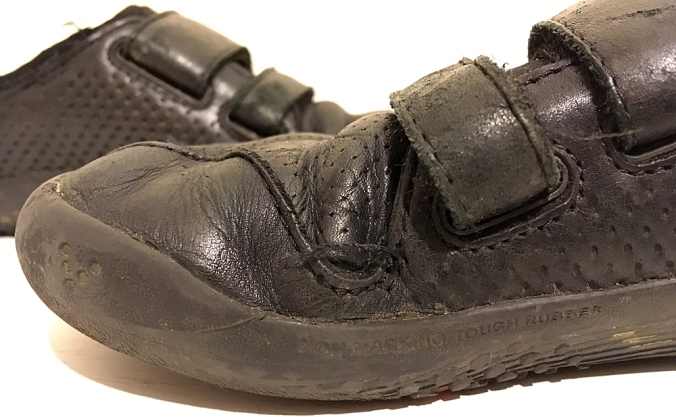
Inov-8 recently celebrated the 10th birthday of their iconic X-Talon shoe. I remember the distinctive black and yellow of the first model, and ever since then I seem to see the characteristic X-Talon footprint wherever I run.
I know many people for whom these have become the indispensable trail and fell shoe, but despite the many Inov-8 shoes that I have run in, I’ve never had a pair of X-Talons. So, I was very pleased to be offered a pair of the new 2018 X-Talon 230s to test and review.
These come in at the 2-arrow mark on Inov-8’s scale of forefoot drop, equating to 6mm between heel and forefoot, with 7mm / 13mm stack height. And at 230g they are just about at the limit of my minimalist preference.
The exciting new feature of these latest X-Talons is the Sticky Grip; a new rubber compound for the outsole which purports to offer superior traction on wet or dry hard ground.

They feature a ‘second-generation meta-plate’ within the midsole, which provides a protective layer between your flesh and whatever it is you’re landing on. They also feature the ‘Powerflow+’ midsole which they say delivers 10% better shock absorption and 25% better energy return than standard midsoles.
I have to say that this is beginning to sound a bit gimmicky, like that of so many of the mainstream running shoes that steered me towards barefoot and minimalist shoes in the first place. However, I started my journey with Inov-8 and I have faith in them and the research that goes into their products.
They are a very narrow fit, being classified as a 1 on their Shoe Fit Scale; being the closest, most precise fit of their range. For me, this does present a problem. My feet are wide, and they have got used to being able to spread naturally in many of my wide-fitting barefoot shoes. Putting the X-Talons on for the first time felt like a proper squeeze.
I was warned by Inov-8 that they’d feel stiff and tight to start with, so my first few outings in them were dog-walks, just to bed them in and let them loosen up. This they did, and after several hours of walking in terrain they fitted nicely, albeit a very snug fit.
I’ve worn them for runs of up to two hours, but after that length of time I very much look forward to removing them to let my toes unfurl.
Having said that, I do acknowledge the benefits of narrow fitting shoes. Prior to testing these X-Talons I’d spent most of my time recently in the Vivobarefoot Primus Trail SG, which are similarly aggressive trail shoes, but with a truly wide-fitting. I love the freedom afforded by those wide toe boxes, but there is a certain amount of slippage inside the shoe especially when contouring hillsides or on uneven ground. The narrow fit of the X-Talons affords no internal movement and consequently you know exactly where your foot is, and you have confidence that it’s going to stay there.
This confidence is strengthened by the immense gripping power of the X-Talon soles.

I now understand why these have been at the forefront of trail and fell shoes for ten years. They just hold unbelievably tight into soft ground. And these new Sticky Grip soles definitely do provide traction on hard surfaces, be that wet or dry bare rock, tarmac, or concrete. I’ve not felt this confident with one pair of shoes on all of these surfaces since the Icebug Accelleritas.
The uppers are tough and durable. On top is a very abrasion-resistant fabric that does not retain water, and that holds its own through rough, scratchy undergrowth. When they come home soaked, they can be dry by the next day. There’s a pretty tough rand (or bumper) all around the front and sides to further help protect the shoe from abrasion.
The tongue is gusseted, which helps to keep out debris and water. The laces are long enough to tie a double knot, but not too long to be a snag risk. There are discreet integrated hooks on the sides of the uppers to hold Inov-8’s All Terrain Gaiter.
I wore them recently for a 12-mile hilly winter multi-terrain race. Footwear for this annual race is always a difficult decision on account of the varying terrain and unpredictability of the conditions of the trails and off-trails. I will no longer struggle with that decision. These shoes fitted the bill perfectly and helped me achieve my best result yet, with unsurpassed traction throughout.

All told, these are awesome shoes. They are my new favourite off-road race shoe. Due to their narrowness and the associated discomfort after more than two hours, I will limit their use to the wettest/stickiest training runs, but for any future off-road and multi-terrain races, these are my new go-to shoe.

















 Having spent many happy hours running in the
Having spent many happy hours running in the 
 In time for the summer season Vivobarefoot has released the latest version of their classic Ultra shoe for kids. This is a fantastic all-purpose barefoot shoe and I’ve been wearing the
In time for the summer season Vivobarefoot has released the latest version of their classic Ultra shoe for kids. This is a fantastic all-purpose barefoot shoe and I’ve been wearing the 






 Its sole is the same as the
Its sole is the same as the 



 The sole’s sticky rubber offers good traction on most surfaces whether you’re running, walking, playing, or in the water, and although the embossed detail of the ‘tread’ texture will wear off quickly on hard surfaces, the 4mm rubber will take many many miles to wear through to your own sole.
The sole’s sticky rubber offers good traction on most surfaces whether you’re running, walking, playing, or in the water, and although the embossed detail of the ‘tread’ texture will wear off quickly on hard surfaces, the 4mm rubber will take many many miles to wear through to your own sole.

 The sole is 14mm thick under the heel with a 4mm drop to the forefoot. Not as minimalist as one might expect from the makers of the 4+1, but this is certainly towards that end of the spectrum. You don’t get the ‘Princess and the Pea’ underfoot sensation that you do from the likes of Inov-8’s Baregrip and Trailroc 150 or the Vivobarefoot Neo Trail or Trail Freak, but you don’t always want to know about every little lump and bump, especially when you’re hammering it down a steep rocky hillside. In that respect the Mudgrips offer a welcome balance of minimalism and protective cushioning.
The sole is 14mm thick under the heel with a 4mm drop to the forefoot. Not as minimalist as one might expect from the makers of the 4+1, but this is certainly towards that end of the spectrum. You don’t get the ‘Princess and the Pea’ underfoot sensation that you do from the likes of Inov-8’s Baregrip and Trailroc 150 or the Vivobarefoot Neo Trail or Trail Freak, but you don’t always want to know about every little lump and bump, especially when you’re hammering it down a steep rocky hillside. In that respect the Mudgrips offer a welcome balance of minimalism and protective cushioning.
 In all other aspects this is a highly eligible debut off-trail shoe from Freet which has outstanding grip, a minimalist yet adequately cushioned sole, and which will give its peers a serious run for their money in a variety of terrains.
In all other aspects this is a highly eligible debut off-trail shoe from Freet which has outstanding grip, a minimalist yet adequately cushioned sole, and which will give its peers a serious run for their money in a variety of terrains.

 The sole is a ‘sticky’ rubber compound moulded to match the contours of your own feet, while the uppers are a soft supple and insulating neoprene with a Velcro-type fastening.
The sole is a ‘sticky’ rubber compound moulded to match the contours of your own feet, while the uppers are a soft supple and insulating neoprene with a Velcro-type fastening.